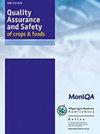Plumbagin attenuates high glucose-induced trophoblast cell apoptosis and insulin resistance via activating AKT/mTOR pathway
IF 5.3
3区 农林科学
Q1 FOOD SCIENCE & TECHNOLOGY
引用次数: 2
Abstract
Plumbagin, a bioactive phytoconstituent, is isolated from the root of Plumbago zeylanica L. Plumbagin pos-sesses antidiabetic effect to mediate glucose homeostasis, wound healing and diabetic nephropathy. However, the involvement of plumbagin in gestational diabetes mellitus (GDM) has not been reported yet. Trophoblast cell line (HTR8/SVneo) was incubated with high glucose to establish cell model of GDM. Cell viability and proliferation were detected by MTT and EdU staining. Flow cytometry was used to investigate cell apoptosis. Cell viability of HTR8/SVneo was reduced by high glucose or incubation of plumbagin. Plumbagin restored reduced cell viability and proliferation of HTR8/SVneo induced by high glucose. Plumbagin attenuated high glucose-induced cell apoptosis in HTR8/SVneo cells through upregulation of Bcl-2 and down-regulation of Bax, cleaved caspase-3 and cleaved caspase-9. Protein expression of glucose transporter type 4 (GLUT-4), insulin receptor (INSR)-B and INSR substrate (IRS1) was decreased in high glucose-induced HTR8/SVneo but increased by plumbagin. The suppressive effects of high glucose on phosphorylation of AKT and mTOR in HTR8/SVneo were reversed by plumbagin. Plumbagin improved high glucose-induced cell apoptosis and insulin resistance of HTR8/SVneo through activation of AKT/mTOR pathway, suggesting that plumbagin might be used as a potential strategy for the prevention of GDM.Plumbagin通过激活AKT/mTOR途径减轻高糖诱导的滋养层细胞凋亡和胰岛素抵抗
Plumbagin是一种具有生物活性的植物成分,从Plumbago zeylanica L.的根中分离得到。Plumbagin具有介导葡萄糖稳态、伤口愈合和糖尿病肾病的抗糖尿病作用。然而,铅蛋白与妊娠期糖尿病(GDM)的关系尚未见报道。用高糖培养滋养层细胞系HTR8/SVneo,建立GDM细胞模型。MTT法和EdU法检测细胞活力和增殖情况。流式细胞术检测细胞凋亡。HTR8/SVneo的细胞活力通过高糖或铅金的孵育而降低。Plumbagin恢复了高糖诱导的HTR8/SVneo降低的细胞活力和增殖。Plumbagin通过上调Bcl-2和下调Bax、裂解胱天蛋白酶-3和裂解胱天酶-9来减弱高糖诱导的HTR8/SVneo细胞凋亡。在高糖诱导的HTR8/SVneo中,葡萄糖转运蛋白4型(GLUT-4)、胰岛素受体(INSR)-B和INSR底物(IRS1)的蛋白表达降低,但铅蛋白增加。高葡萄糖对HTR8/SVneo中AKT和mTOR磷酸化的抑制作用被铅蛋白逆转。Plumbagin通过激活AKT/mTOR途径改善高糖诱导的HTR8/SVneo细胞凋亡和胰岛素抵抗,表明Plumbagin可能是预防GDM的潜在策略。
本文章由计算机程序翻译,如有差异,请以英文原文为准。
求助全文
约1分钟内获得全文
求助全文
来源期刊

Quality Assurance and Safety of Crops & Foods
FOOD SCIENCE & TECHNOLOGY-
CiteScore
4.60
自引率
7.50%
发文量
61
审稿时长
1 months
期刊介绍:
''Quality Assurance and Safety of Crops & Foods'' is an international peer-reviewed journal publishing research and review papers associated with the quality and safety of food and food sources including cereals, grains, oilseeds, fruits, root crops and animal sources. It targets both primary materials and their conversion to human foods. There is a strong focus on the development and application of new analytical tools and their potential for quality assessment, assurance, control and safety. The scope includes issues of risk assessment, traceability, authenticity, food security and socio-economic impacts. Manuscripts presenting novel data and information that are likely to significantly contribute to scientific knowledge in areas of food quality and safety will be considered.
''Quality Assurance and Safety of Crops & Foods'' provides a forum for all those working in the specialist field of food quality and safety to report on the progress and outcomes of their research.
 求助内容:
求助内容: 应助结果提醒方式:
应助结果提醒方式:


